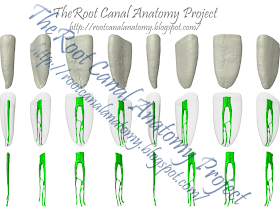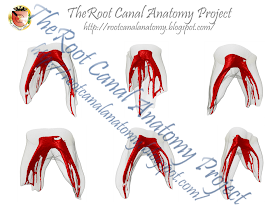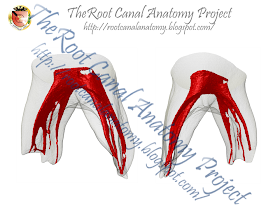Frontal and lateral views of a 3-D reconstruction of a maxillary first premolar showing a three-rooted canal system. This micro-CT image was developed as part of the Root Canal Anatomy Project in the Laboratory of Endodontics of the University of Sao Paulo in Ribeirao Preto, Brazil by Prof. Marco Versiani, Prof. Jesus Pécora & Prof. Manoel Sousa-Neto.
October 21, 2013
Publication JOE
Abstract
Introduction
This study aimed to describe the anatomy of mandibular central and lateral incisors using micro–computed tomographic imaging.
Methods
One hundred mandibular incisors were scanned in a micro–computed tomographic device using an isotropic resolution of 22.9 μm. The anatomy of each tooth (length of the roots, presence and location of accessory canals and apical deltas, and number of canals) as well as the 2- and 3-dimensional morphologic aspects of the canal (area, roundness, diameter, volume, surface area, and structure model index) were evaluated. Data were statistically compared using the Student t test (alpha = 0.05).
Results
The mean lengths of the mandibular central and lateral incisors were 20.71 and 21.56 mm, respectively. Most of the central (60%) and lateral (74%) incisors had no accessory canals. An apical delta was observed in only 1 specimen. The cross-section analysis of the apical third showed the presence of 1, 2, or 3 canal orifices. No statistical difference was observed in the comparison of the 2- and 3-dimensional morphologic parameters between central and lateral incisors (P < .05). The qualitative analyses of the 3-dimensional models of the root canal systems of the central and lateral incisor teeth confirm that the most prevalent configurations were Vertucci's types I (50% and 62%, respectively) and III (28%).
Conclusions
Overall, mandibular central and lateral incisors were similar in terms of the 2- and 3-dimensional analyzed parameters. Vertucci's types I and III were the most prevalent canal configurations of the mandibular incisors; however, 8 new types have also been described.
Publication JOE
Abstract
Introduction
The accumulation of debris occurs after root canal preparation procedures specifically in fins, isthmus, irregularities, and ramifications. The aim of this study was to present a step-by-step description of a new method used to longitudinally identify, measure, and 3-dimensionally map the accumulation of hard-tissue debris inside the root canal after biomechanical preparation using free software for image processing and analysis.
Methods
Three mandibular molars presenting the mesial root with a large isthmus width and a type II Vertucci's canal configuration were selected and scanned. The specimens were assigned to 1 of 3 experimental approaches: (1) 5.25% sodium hypochlorite + 17% EDTA, (2) bidistilled water, and (3) no irrigation. After root canal preparation, high-resolution scans of the teeth were accomplished, and free software packages were used to register and quantify the amount of accumulated hard-tissue debris in either canal space or isthmus areas.
Results
Canal preparation without irrigation resulted in 34.6% of its volume filled with hard-tissue debris, whereas the use of bidistilled water or NaOCl followed by EDTA showed a reduction in the percentage volume of debris to 16% and 11.3%, respectively. The closer the distance to the isthmus area was the larger the amount of accumulated debris regardless of the irrigating protocol used.
Conclusions
Through the present method, it was possible to calculate the volume of hard-tissue debris in the isthmuses and in the root canal space. Free-software packages used for image reconstruction, registering, and analysis have shown to be promising for end-user application.
September 28, 2013
Why does mandibular incisor fail?
Usually, teeth with single roots present single canals as in mandibular and maxillary anterior teeth. However, particular tooth types, such as mandibular premolars and incisors, are recognized as exhibiting a distinct range of variations in the morphology of their root canal system. In mandibular incisors, often a dentinal bridge is present in the pulp chamber dividing the root into two canals. The two canals usually join and exit through a single apical foramen, but they may persist as two separate canals. On occasion one canal branches into two canals, which subsequently rejoin into a single canal before reaching the apex. The incidence of two canals in mandibular incisors has been reported to be as low as 0.3% and as high as 45.3%. The wide range of variation reported in the literature regarding the prevalence of a second canal in mandibular incisors has been mostly related to methodological and racial differences.
(Very soon on the Journal of Endodontics)
August 20, 2013
CLOI Publication
Abstract
Objectives
The aim of this study was to assess the efficacy of removing the filling material from oval-shaped canals with rotary retreatment files, with or without the additional use of self-adjusting file (SAF), using micro-computed tomography.
Materials and methods
Oval-shaped canals from 20 maxillary premolars were prepared and assigned to two groups (n = 10), according to the obturation technique: cold lateral condensation (CLC) or vertical condensation (VC). Then, retreatment procedure was performed with retreatment rotary instruments followed by SAF. The specimens were scanned after each procedure and the volume of the filling material calculated. Median and interquartile range (IQR) percentages of the remaining filling material after each retreatment technique were statistically compared by Wilcoxon and Mann–Whitney U tests with a significance level of 5 %.
Results
The median percentage volume of the filling residue after rotary retreatment procedure was 1.59 (IQR = 1.26) and 0.42 (IQR = 0.86) in the CLC and VC groups, respectively (p < 0.05). After the use of SAF, the median percentage was 1.26 (IQR = 0.75) and 0.12 (IQR = 0.53) in the CLC and VC groups, respectively (p < 0.05). Statistically significant difference was also observed within the group after the additional use of SAF (p < 0.05).
Conclusions
None of the retreatment procedures completely removed the filling material. The additional use of the SAF improved the removal of filling material after the retreatment procedure with rotary instruments.
Clinical relevance
Filling material left after retreatment procedure may harbour necrotic tissue and bacteria, which could lead to a persistent disease and reinfection of the root canal system. The additional use of self-adjusting file after the conventional retreatment procedures may improve root canal cleanliness, allowing a better action of the irrigating solution.
August 10, 2013
JOE Publication
Abstract
Introduction
This ex vivo study evaluated the disinfecting and shaping ability of 3 protocols used in the preparation of mesial root canals of mandibular molars by means of correlative bacteriologic and micro–computed tomographic (μμCT) analysis.
Methods
The mesial canals of extracted mandibular molars were contaminated with Enterococcus faecalis for 30 days and assigned to 3 groups based on their anatomic configuration as determined by μCT analysis according to the preparation technique (Self-Adjusting File [ReDent-Nova, Ra’anana, Israel], Reciproc [VDW, Munich, Germany], and Twisted File [SybronEndo, Orange, CA]). In all groups, 2.5% NaOCl was the irrigant. Canal samples were taken before (S1) and after instrumentation (S2), and bacterial quantification was performed using culture. Next, mesial roots were subjected to additional μCT analysis in order to evaluate shaping of the canals.
Results
All instrumentation protocols promoted a highly significant intracanal bacterial reduction (P < .001). Intergroup quantitative and qualitative comparisons disclosed no significant differences between groups (P > .05). As for shaping, no statistical difference was observed between the techniques regarding the mean percentage of volume increase, the surface area increase, the unprepared surface area, and the relative unprepared surface area (P > .05). Correlative analysis showed no statistically significant relationship between bacterial reduction and the mean percentage increase of the analyzed parameters (P > .05).
Conclusions
The 3 instrumentation systems have similar disinfecting and shaping performance in the preparation of mesial canals of mandibular molars.
Key Words: Bacterial reduction, endodontic treatment, micro–computed tomography, reciprocating motion, Self-Adjusting File, single-file instrumentation
JOE Publication
Abstract
Introduction
The newly developed single-file systems claimed to be able to prepare the root canal space with only 1 instrument. The present study was designed to test the null hypothesis that there is no significant difference in the preparation of oval-shaped root canals using single- or multiple-file systems.
Methods
Seventy-two single-rooted mandibular canines were matched based on similar morphologic dimensions of the root canal achieved in a micro–computed tomographic evaluation and assigned to 1 of 4 experimental groups (n = 18) according to the preparation technique (ie, Self-Adjusting File [ReDent-Nova, Ra’anana, Israel], WaveOne [Dentsply Maillefer, Ballaigues, Switzerland], Reciproc [VDW, Munich, Germany], and ProTaper Universal [Dentsply Maillefer] systems). Changes in the 2- and 3-dimensional geometric parameters were compared with preoperative values using analysis of variance and the post hoc Tukey test between groups and the paired sample t test within groups (α = 0.05).
Results
Preparation significantly increased the analyzed parameters; the outline of the canals was larger and showed a smooth taper in all groups. Untouched areas occurred mainly on the lingual side of the middle third of the canal. Overall, a comparison between groups revealed that SAF presented the lowest, whereas WaveOne and ProTaper Universal showed the highest mean increase in most of the analyzed parameters (P < .05).
Conclusions
All systems performed similarly in terms of the amount of touched dentin walls. Neither technique was capable of completely preparing the oval-shaped root canals.
Key Words: Micro–computed tomography, nickel-titanium instruments, reciprocating motion, root canal preparation, self-adjusting file
JOE Publication
Abstract
Introduction
This study aimed to describe the anatomy of mandibular premolars with type IX canal configuration by using micro–computed tomography.
Methods
Mandibular premolars with radicular grooves (n = 105) were scanned, and 16 teeth with type IX configuration were selected. Number and location of canals, distances between anatomic landmarks, occurrence of apical delta, root canal fusion, and furcation canals, as well as 2-dimensional (area, perimeter, roundness, major and minor diameters) and 3-dimensional (volume, surface area, and structure model index) analysis were performed. Data were statistically compared by using analysis of variance and Kruskal-Wallis tests (α = 0.05).
Results
Overall, specimens had 1 root with a main canal that divided into mesiobuccal, distobuccal, and lingual canals at the furcation level. Mean length of the teeth was 22.9 ± 2.06 mm, and the configuration of the pulp chamber was mostly triangle-shaped. Mean distances from the furcation to the apex and cementoenamel junction were 9.14 ± 2.07 and 5.59 ± 2.19 mm, respectively. Apical delta, root canal fusion, and furcation canals were present in 4, 5, and 10 specimens, respectively. No statistical differences were found in the 2-dimensional and 3-dimensional analyses between root canals (P > .05).
Conclusions
Type IX configuration of the root canal system was found in 16 of 105 mandibular premolars with radicular grooves. Most of the specimens had a triangle-shaped pulp chamber. Within this anatomic configuration, complexities of the root canal systems such as the presence of furcation canals, fusion of canals, oval-shaped canals in the apical third, small orifices at the pulp chamber level, and apical delta were also observed.
Key Words: Complex root canal system, dental anatomy, mandibular premolars, micro-computed tomography
June 22, 2013
A New MicroCT-Based Educational Resource
Realistic visualization by volume rendering
The volume rendering program CTvox (Brucker-MicroCT) for mobiles under iOS is a volume rendering app that runs on Apple iPad/iPhone/iPod. CTVox displays set of reconstructed slices as a realistic 3D object with intuitive navigation and manipulation of both object and camera, a flexible clipping tool to produce cut-away views, background selection including custom scenery and an interactive transfer function control to adjust colors and transparency. A "flight recorder" function allows fast creation of "fly around" and "fly through" animations based on the selection of several key frames with automatic interpolation in between. Imaging possibilities include lighting, shadows and stereo viewing.
This app is available free of charge through the App Store.
The app's manual is available as a PDF, both for the iPad and the iPhone/iPod versions.
Volume data for the CTvox app is stored in a VXM file. A VXM file contains both the volume data and an associated transfer function. Now, you will be able to rotate, cut, color, create movies, and whatever you wanted, in real-time, from real 3D datasets of all teeth acquired using micro-CT technology!
For educational purposes,
the Root Canal Anatomy Project will provide you
with VXM files of all groups of teeth
Download links:
Maxillary Teeth
central incisor, lateral incisor, canine, 1st premolar, 2nd premolar, 1st molar, 2nd molar, 3rd molar
Mandibular Teeth
ENJOY!
June 16, 2013
June 15, 2013
Impressions from Chile 2013
Board of Direction (from left to right): Dr. Carlos Olguín, Dra. Milena Souto, Dr. Wenceslao Valenzuela, Dra. Mónica Pelegrí, Dr. Marcelo Navia (president), Dra. Olga Ljubetic, Dra. Pilar Araya, Dr. Mauricio Garrido, Dra. Andrea Dezerega, Dra. Marcia Antúnez (past president)


















































